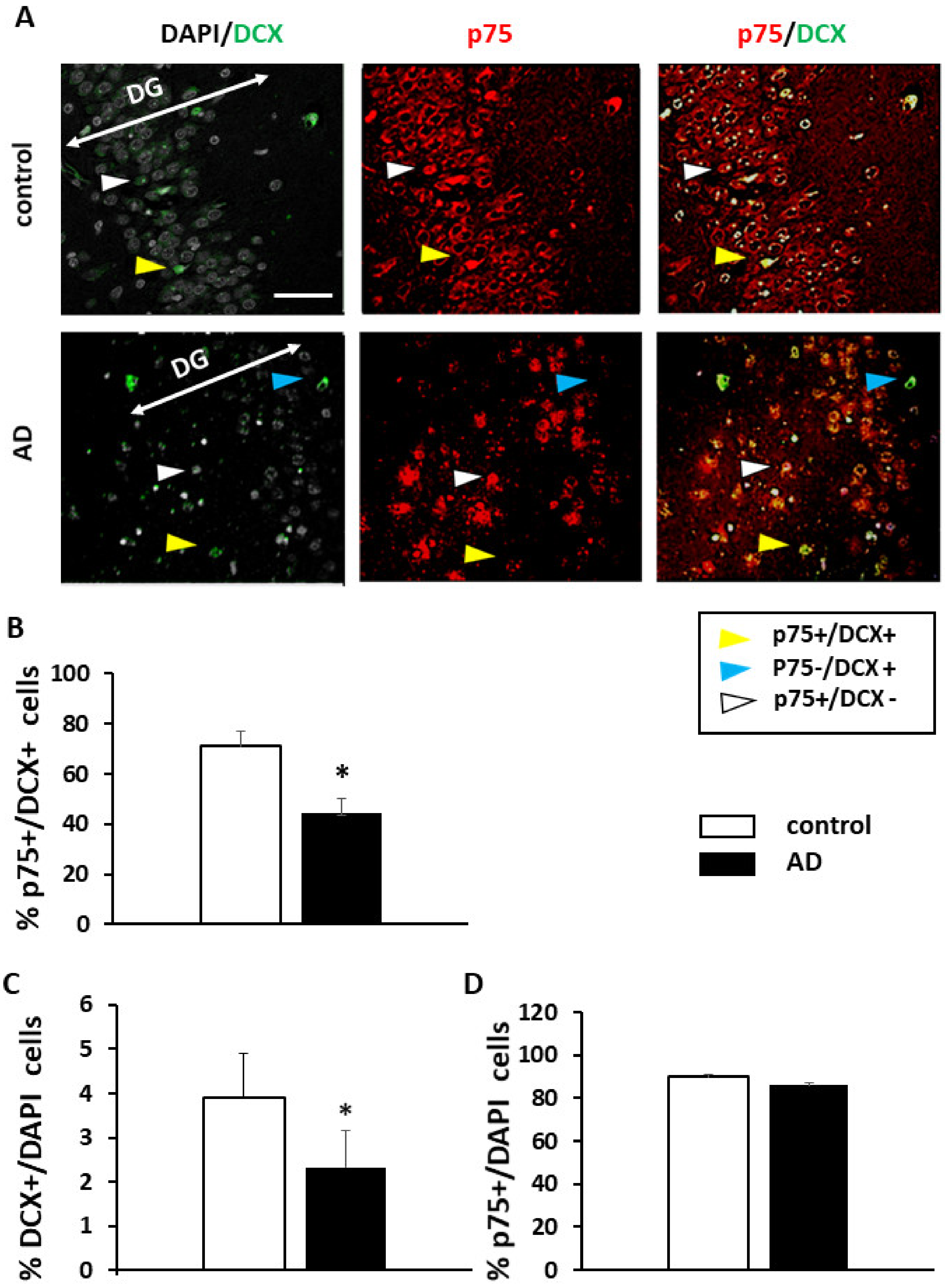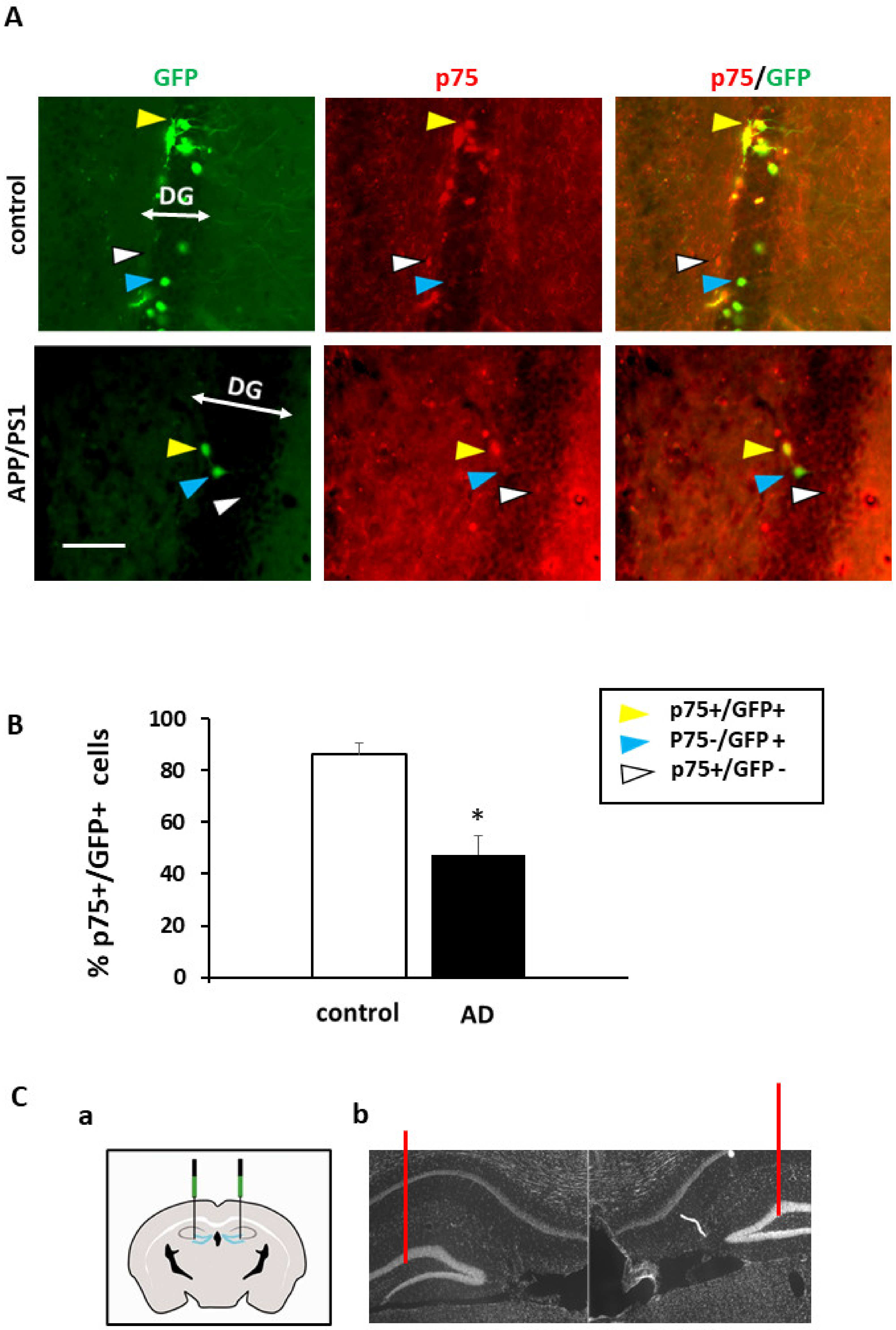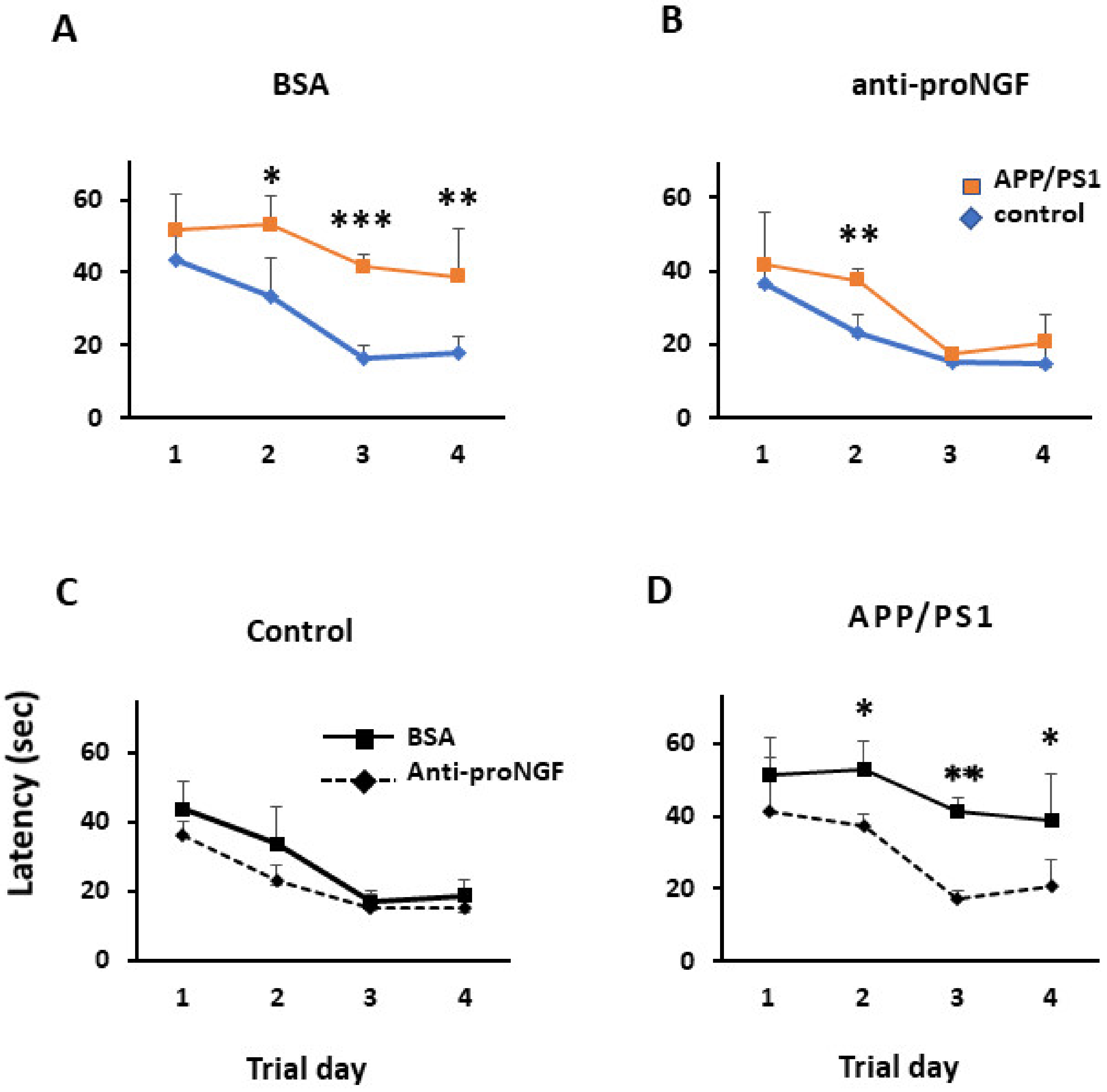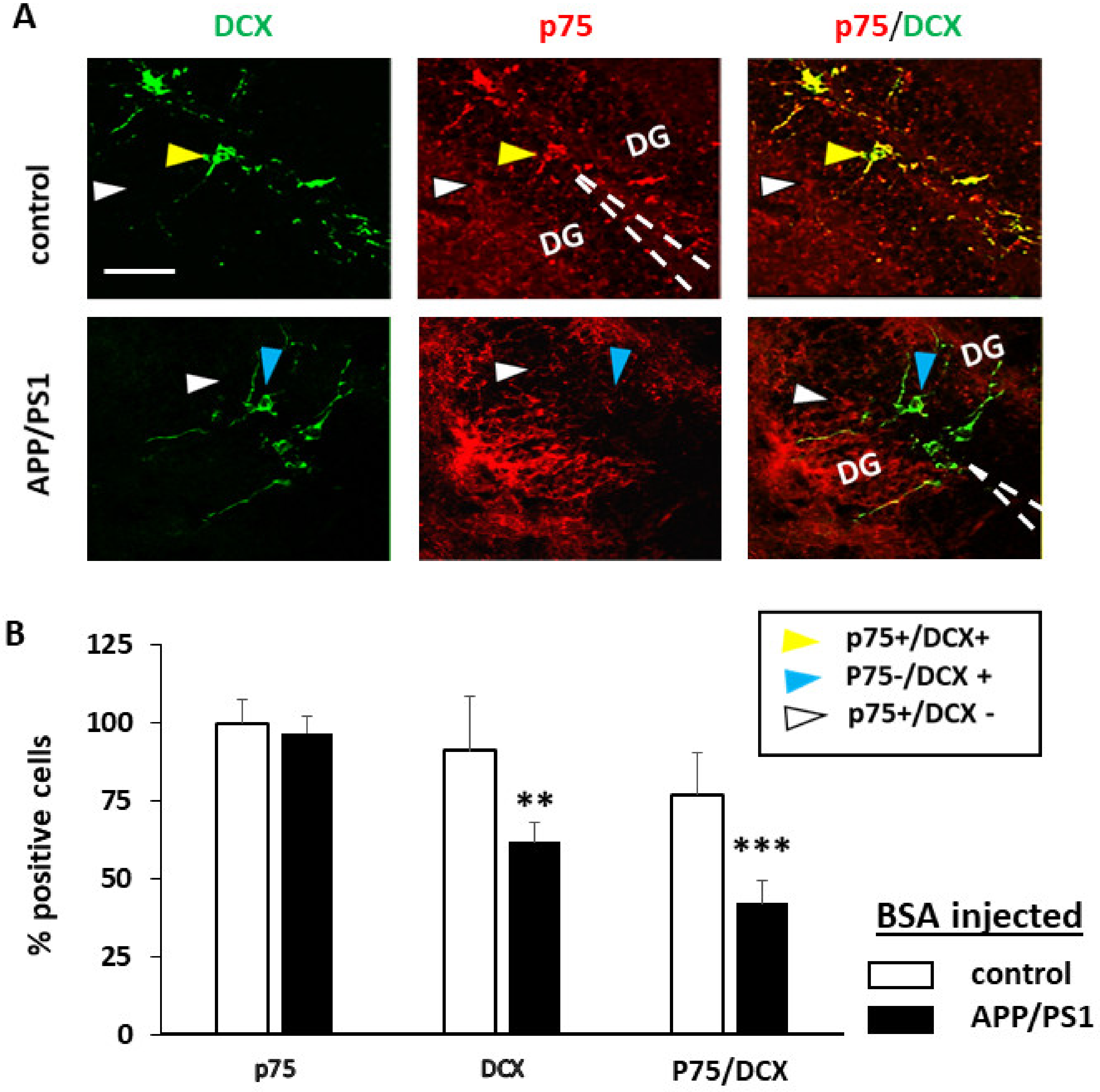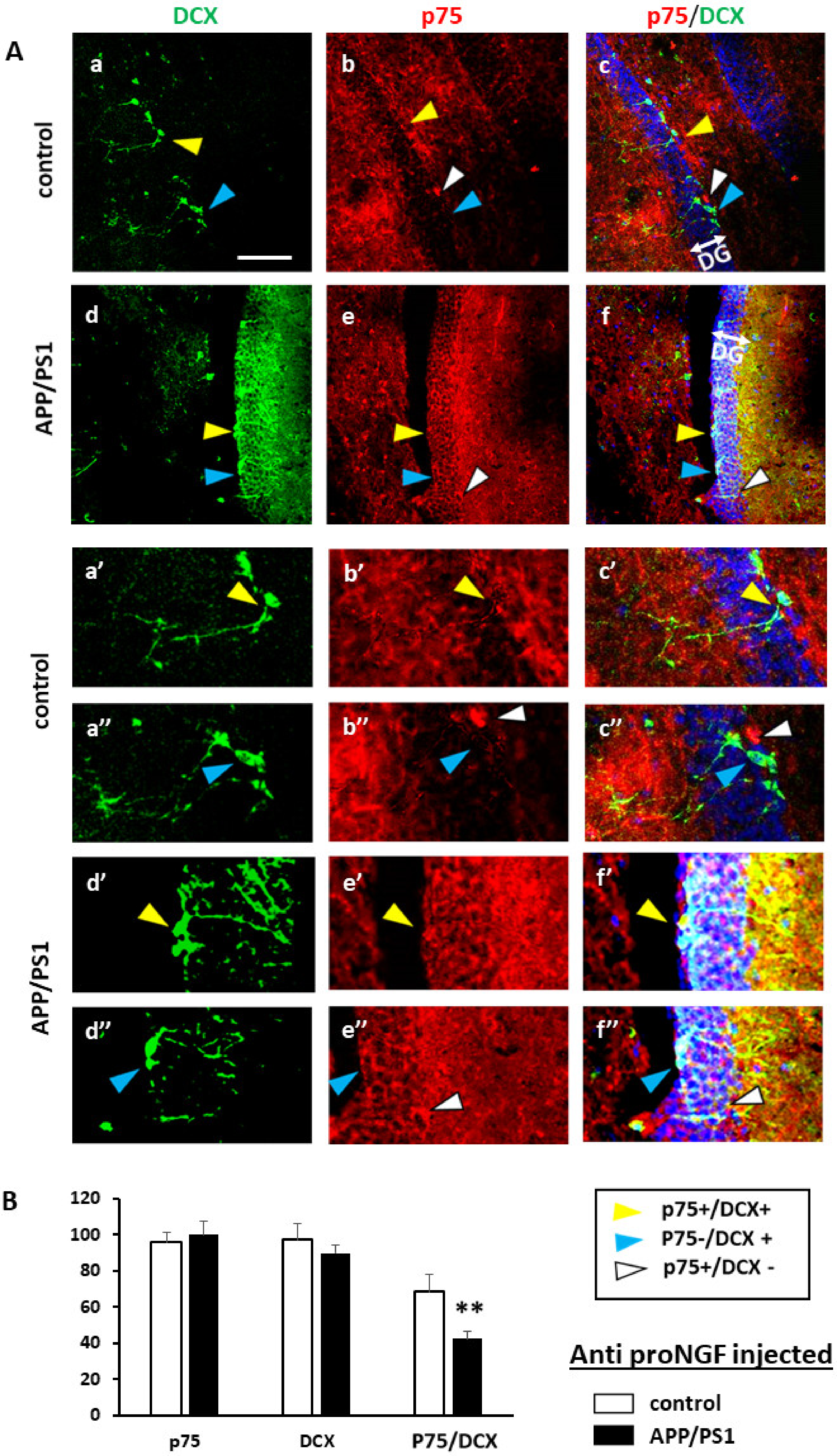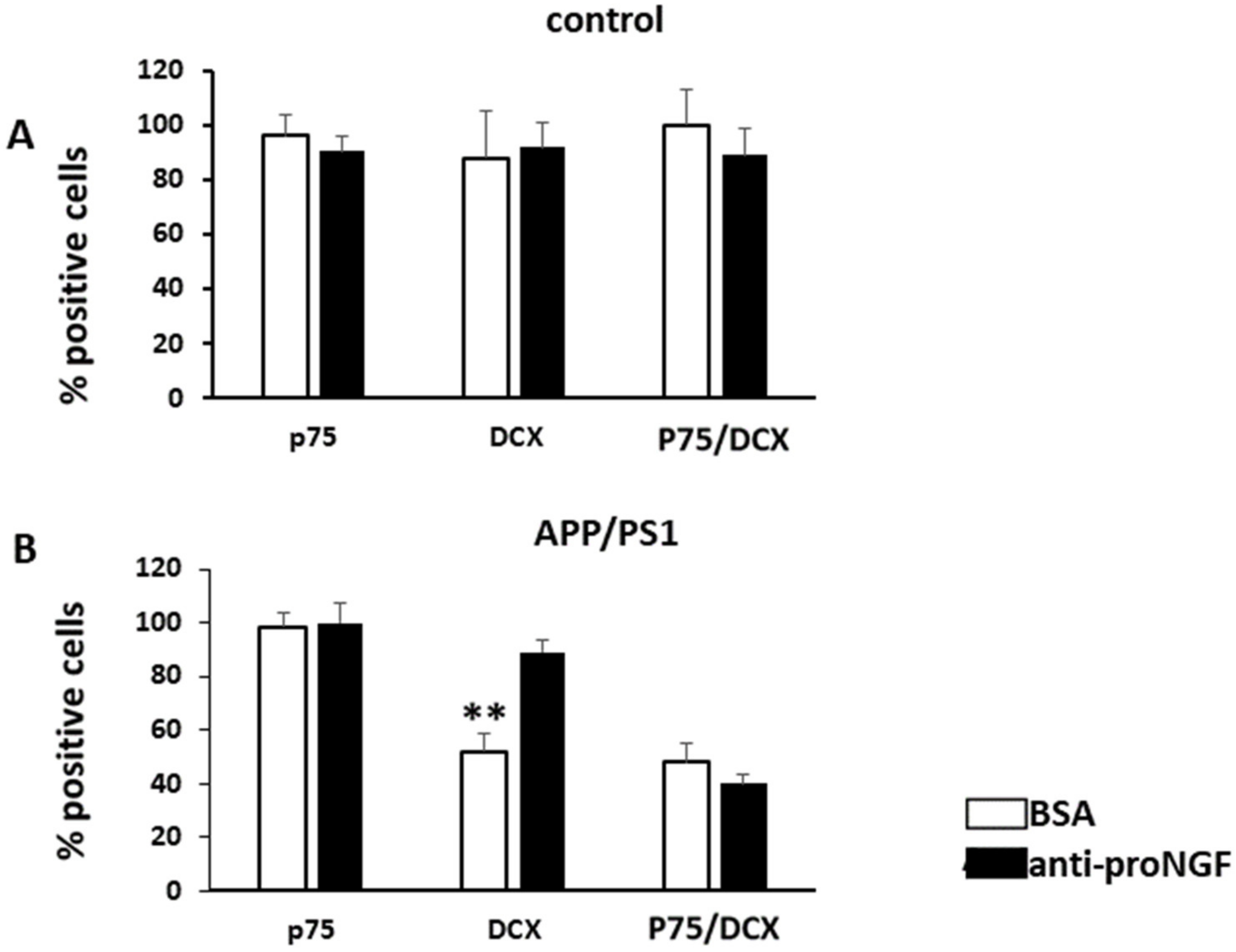1. Background
The neurodegenerative process involved in Alzheimer’s Disease (AD) pathogenesis often begins with memory loss and results in defects in multiple cortical activities later on. It is no longer new that adult neurogenesis occurs in the human brain and contributes to the cognitive functioning of the hippocampus [
1,
2]. Empirical evidence has shown that adult neurogenesis declines with age and that alteration of the neurogenic process contributes to the cognitive deterioration and learning difficulties and memory loss in AD [
3,
4,
5,
6].
In the mouse, adult-generated neurons are formed in two main brain regions: the subgranular zone (SGZ) located in the dentate gyrus of the hippocampus, and the subventricular zone (SVZ) of the lateral ventricles, which contains lateral, medial, and dorsal microdomains [
7]. In the hippocampus, new functional neural cells arise from the adult neural stem cells (NSCs) via the amplification of intermediate progenitors and neuroblasts, followed by the integration of these new neurons into existing neural circuits [
8].
Hippocampal neurogenesis has received considerable attention over recent decades because of its role in learning and memory [
9,
10] and because during AD it has been shown that hippocampal adult neurogenesis is greatly impaired and significantly contributes to learning and memory deficits associated with this pathology [
2,
3,
4,
11].
During adult neurogenesis, newly born cells express distinct neurogenic markers characteristic of the different stages of the process. The Primary Neural Progenitor cells (type 1 cells) are located in the subgranular cell layer (SGL) of the DG, where they slowly divide and express stem cell markers such as nestin and Sox2. They then give rise to intermediate Neuronal Progenitor Cells (type 2 cells), which are more proliferative and have only short processes. Type 2 cells are categorized into type 2a and 2b cells; type 2a cells express stem cell markers and type 2b cells express immature neuronal markers such as doublecortin (DCX), and they in turn give rise to more mature neurons, expressing first calretinin+ and then calbindin protein, reflecting their complete differentiation into granular neurons. During the second week after cell division, new-born neurons begin to extend their axonal processes to the CA3 region of the hippocampus and their dendritic processes towards the molecular layer [
8]. At this stage, electrophysiological recordings show that they receive direct, slow GABAergic synaptic input, and start to show spines on dendrites. Between 4 and 6 weeks after birth, these neurons become fully mature and integrated into the circuit [
12,
13,
14]. The decline of adult hippocampal neurogenesis observed with aging and to a greater extent in age-related pathological conditions such as AD suggests that neurogenesis plays a crucial role in proper brain functioning, including learning and memory (2). Thus, practical approaches to boost adult neurogenesis during neurodegeneration may be a promising strategy to combat the progressive loss of neurons and related cognitive dysfunction associated with AD. For this, it is essential to know the exact molecular mechanisms involved in the loss of adult neurogenesis during AD.
Neurotrophins are a broad family of secreted growth factors that are important for the survival, growth, and maintenance of neurons, with a crucial role in synaptic plasticity, learning and memory [
15,
16]. Of particular interest are nerve growth factor (NGF) and brain derived neurotrophic factor (BDNF). Most neurotrophic factors are synthesized as precursor forms (pro-forms, such as pro-NGF or pro-BDNF) and undergo proteolytic cleavage to render the mature neurotrophic forms under physiological conditions, the mature form of neurotrophins is generally produced from the intracellular activities of proteases such as convertases to elicit their trophic functions (17). Numerous studies have shown that proneurotrophins may be secreted without being cleaved, and this has deleterious effects on neuronal function [
5,
6,
17,
18,
19,
20]. The pro and mature forms of these neurotrophins have different affinities and specificities for various receptors, such as the p75 neurotrophic receptor (p75NTR). p75NTR belongs to the TNF family (tumor necrosis factor) of death receptors but has no catalytic activity. It has multiple roles in cellular homeostasis, apoptosis, cell cycle arrest, survival and proliferation which depend on the ligand and co-receptor binding to p75NTR [
21]. For instance, when bound to mature neurotrophins, p75NTR interacts with Trk receptors to promote cell survival [
15,
16]. On the other hand, when p75NTR binds by precursor forms of neurotrophins, such as proNGF and proBDNF, it interacts with sortilin to form p75NTR-sortilin receptor complex, which trigger several death signaling pathways. These include NRAGE and NRIF and JNK kinases [
21,
22,
23] or the processing of p75NTR intracellular domain (ICD) by two secretases, α and γ, releasing the 20 kDa ICD fragment (p75ICD) which interacts with TRAF6 and NRIF and translocate to the nucleus to facilitate the expression of proapoptotic genes [
18,
24,
25,
26,
27].
Interestingly, several studies have implicated the precursor forms of the neurotrophins in many aspects of the pathogenesis of AD, especially in cell death [
17,
18,
19,
24]. For instance, in a previous study, we described how intra cerebro ventricular (ICV) injection of proNGF elicited spatial memory deficits in control mice, similar to those observed in AD mouse models such as the APP/PS1 mice [
18,
19]. This effect is probably exacerbated by the observation that under pathological conditions such as in AD, there is an increase of oxidative stress that may affect proneurotrophins (by undergoing advanced end glycation products (AGE)-derived modifications) that prevent proteolytic cleavage and maturation thus impairing cell survival and facilitating cell death [
18,
19,
24]. However, it remains unclear whether the pro-neurotrophin/p75NTR signaling is involved in other processes beyond cell death, related to the AD pathology. In the present study, we investigated the contribution of the pro-NGF/p75NTR signaling pathway in adult hippocampal neurogenesis in AD patients and in APP/PS1 transgenic mouse model for AD and its impact in the cognitive dysfunctions of the disease. In AD models, the percentage of DCX+ progenitor cells in the DG is reduced. We found that p75NTR is expressed in these DCX+ cells in both controls and AD. However, the levels of p75NTR in DCX+ progenitor cells are significantly decreased, suggesting a role of p75NTR signaling in adult neurogenesis in AD. Interestingly, injection of neutralizing antibodies against proNGF restored the memory loss of APP/PS1 AD mouse model and increase the percentage of DCX+ progenitor cells in the DG of these animals.
2. Methods
2.1. Human Brain Samples
Brain samples were obtained from the Institute of Neuropathology, Bellvitge University Hospital. Brain tissues were obtained from the Institute of Neuropathology HUB-ICO-IDIBELL Biobank and the Hospital Clinic-IDIBAPS Biobank following the guidelines of Spanish legislation on this matter (Real Decreto de Biobancos 1716/2011) and approval of the local ethics committees (
Table 1 and
Table 2). For autopsy, one hemisphere was rapidly cut in 1 cm thick coronal sections, and selected areas of the encephalon were dissected, frozen on dry ice, and stored at −80 °C in labelled plastic bags until use. The other hemisphere was fixed by immersion in 4% buffered formalin for three weeks for morphologic examination. The neuropathological study was carried out on twenty-five regions of the cerebral cortex, diencephalon, thalamus, brainstem, and cerebellum. De-waxed paraffin sections were stained with haematoxylin and eosin and Klüver-Barrera, then processed for immunohistochemistry of microglia-specific markers, glial fibrillary acidic protein, β-amyloid, phosphorylated tau, α-synuclein, TDP-43, ubiquitin, and p62. Neuropathological diagnosis of AD was carried out following the Braak and Braak stages [
28] adapted to paraffin sections [
29]. Cases with concomitant pathologies, including Lewy body diseases, tauopathies (particularly argyrophilic grain disease), vascular diseases, TDP-43pathies, and metabolic syndrome were excluded. Control and disease cases were processed in parallel. The anterior hippocampus area was used for further immunohistochemical studies.
2.2. Animal Model
Considering that amyloid precursor protein (APP) and Presenilin 1 (PS1) are mutated in 78% and 18% of the familial cases of Alzheimer, respectively, the double transgenic APP/PS1 mouse model has been one of the most commonly used models in the study of Alzheimer’s disease [
30,
31,
32].
APPswe/PS1dE9 with a C57BL/6 background (double transgenic mice expressing a chimeric mouse/human amyloid precursor protein and a mutant human PS1 with deletion in exon 9) were purchased from the Jackson Laboratory and kept in a specific pathogen-free environment under standard animal housing conditions in a 12 h dark-light cycle with free access to food and water in the animal house facility of the Universitat de Lleida. Heterozygous males were bred with wild-type C57BL/6 females. Animal procedures were conducted according to ethical guidelines (European Communities Council Directive 86/609/EEC) and approved by the local ethics committee of the Universitat de Lleida. For experiments, tail biopsies were taken from P0 offspring for genotyping by PCR according to the PCR conditions suggested by the Jackson Laboratory. Mice not expressing the transgene were used as controls. All the experiments are performed using 50% males and 50% females on average.
2.3. Behavioural Test: Morris Water Maze
The experimental animals were subjected to Morris water maze (MWM) test to assess their cognition/memory associated with hippocampal function [
33,
34]. All of the behavioral procedures were conducted at the same time of day, in an isolated room every day for 4 days. The tank was divided into four virtual quadrants containing one visible and different extra-maze cue each. The cues (black 4 × 4 cm geometric forms) were located at 20 cm from the water in the white circular extra-maze wall. A circular scape platform (diameter 9 cm) was located in the center of one quadrant (target quadrant) and hidden under the opaque water surface (23.5 °C–0.5 °C), in a water tank of 150 cm diameter and 30 cm high. The platform remained at a fixed location during training. The three other quadrants (opposite, adjacent 1 and 2) contained the starting points which were used in a pseudo-randomized order that varied across blocks of training trials. The mouse had to find the invisible platform using the extra-maze cues. Four trials per day with start positions close to the four geometrical signs were carried out, and latency in reaching the platform was recorded. Cut-off time to find the platform was 90 s, and mice failing to find the platform were placed on it and left there for 15 s. Each trial for a single animal was 30 min apart from the previous [
18].
2.4. Stereotaxic Injection
Eight to nine-month old female and male APPsw695/PS1dE9 mice and control animals were placed under isoflurane anesthesia for a couple of minutes, after which they were injected intraperitoneally with the analgesia Rompun (2%) and ketamine (10%) in 0.9% NaCl. Then, mice were fixed securely unto the stereotaxic apparatus, and the skull was carefully exposed. The stereotaxic apparatus was then adjusted to the accurate position after which a metal bar driller was slowly used to make a hole in the skull. A volume of 5 µL per DG of the anti-proNGF antibody [
17] or BSA control solution was gradually injected bilaterally into the dentate gyrus according to the stereotaxic coordinates (Bregma: anteroposterior: 2 mm, lateral: +/− 1.6 mm, dorsolateral: 2.5 mm from the skull), at a speed of 1 µL/min. After the successful injection, the needle was held in place for another minute before it was retracted slowly at the same rate of 1 µL/min speed. After this, the incisions were stitched, and the mice were returned to their home cages for a recovery period of 10 days.
Another set of APP/PS1 transgenic mice were stereotaxically injected with enhanced green fluorescent protein (eGFP) expressing the Moloney leukaemia-derived retroviral vector pCMMP-IRES2eGFP-WPRE. This was carried out using the previously described protocol [
3].
2.5. Immunohistochemistry
A week after the behavioral study, the mice were anesthetized with Rompun (2%, Bayer)/ (Ketamine 0.1 mg/g, Merial) and transcardially perfused with NaCl (9%) followed by 4% PFA in PBS. Brains were dissected and fixed overnight in 4% PFA in PBS, then were washed with PBS 3 times for 10 min and subsequently cryoprotected in 30% sucrose (Scharlau) in PBSO/N, embedded in cryoprotective tissue-freezing medium (General Data), and stored at −80 °C. A volume of 30 µM serial coronal sections (cryosections) were then made using a cryostat (Leica CM 3000, Wetzlar, Germany), and collected in Super frost PlusTM slides (ThermoFisher, Lenexa, KS, USA) and stored at −80 °C for further use.
The immunohistochemistry protocol followed in this study varied slightly according to the sets of samples analyzed: hippocampal slices obtained from blocking α-proNGF stereotaxically injected mice, GFP retroviral-injected mice, or human samples. Pictures at 40X were made from all the DG. Then we selected randomly the number of views enough to cover the 300 DAPI positive neurons. Positive cells are expressed as the average of the % positive on the number of DAPI cells in each field. Co-localization is expressed as % of p75 cells on the total of DCX positive cells in each field. The procedures are summarized as follows:
2.6. Immunostaining Protocol for Human Samples
Human samples were deparaffined by heating them to 62 °C for 30 min and then substituted in xylol 2 times at 10-min intervals. A series of ethanol washes were then done in the lamina flow hood at varying concentrations as follows: 2 times in ethanol 100%, 2 times in ethanol 95%, and 2 times in ethanol 60%; the interval between each of these washes was 5 min. The resulting samples were rinsed in distilled water for 10 min, followed by 3 10-min washes in PBS 1X and then 1 10-min wash in 50 mM NH4Cl+PBS1X. Lipofusion was done under black conditions to eliminate autofluorescence by blocking in black Sudan suspension for 25 min at room temperature before antigen retrieval (10-min wash in preheated Tris-HCl buffer 20 mM pH 9.5 at 97 °C for 20 min), after which it was cooled down. The next step was to wash it in 0.1% PBST 2 times for 15 min and block with 5% donkey serum for 1 h. Primary antibodies were then added at working concentration 1:100 and kept at 4 °C till the next day (rabbit DCX Santa Cruz, Santa Cruz, CA, USA; goat anti-p75ECD R and D, Minneapolis, MN, Canada). On the following day, having spent 28 h in the cold room, the samples were left at room temperature for 2 h before proceeding with the 3 washes in PBST 0.1% at 15-min intervals. The samples were then incubated with secondary antibodies (working dilution 1:10,000 plus DAPI in blocking solution) for 2 h. They were then washed 3 times in PBS Tween 0.1% and a last washing in 0.1% PBS before they were finally mounted with the coverslip using the mounting medium Fluoromount G (Southern Biotech 0100-01, Birmingham, AL, USA).
2.7. Immunostaining Procedure for Mouse Cryosections
The sections were consequently subjected to one-hour blocking and permeabilization process with PBST and 1% donkey serum (5%) (Jackson 017-000-121 IR), then incubated with primary antibodies (in blocking solution 1:100) (rabbit DCX Santa Cruz; goat anti-p75ECD R and D), and subsequently kept at 4 °C for 5 days. On the 5th day, the samples were removed from the cold room and kept at room temperature for 2 h. After that, they were washed three times with PBST 0.1% at 10-min intervals; and then incubated with secondary antibodies in blocking solution (Working dilution 1:10,000 plus DAPI for 2 h at room temperature) (donkey anti-goat Cy3, 1:10,000; donkey anti-rabbit Alexa488, 1:500; donkey anti-mouse Cy3, 1:10,000 (all from Jackson Immunoresearch, Philadelphia, PA, USA). Finally, the cells were washed three more times with PBST 0.1% for 15 min, after which they were mounted with coverslips using Fluoromount G (Southern Biotech 0100-01). Negative controls for secondary antibodies are done (
Supplementary Figure S2).
2.8. Immunostaining Protocol for GFP Retroviral Injected Hippocampal Slices
The mouse hippocampal slices were subjected to immunohistochemistry protocol performed in batches in round-bottomed Eppendorf tubes. The slices were first placed at room temperature for 40 min, followed by 4 free-floating washes with PBST (0.25% Triton) of 5 min each. After that, they were washed 3 times in PBST (0.1%) at 10 min intervals and then in PBST0.1%+NH4Cl 50 mM for 10 min. Antigen retrieval was done using pre-heated citrate buffer and the antigens were then placed in 95 °C boiling water for 30 min. The slices were cooled for about 15 min and washed 2 times in PBST (0.1% Triton) to remove remains of the fixing solution. Then, they were incubated with the blocking solution following the protocol described in the section below but in batches in the Eppendorf tubes. The antibodies were used in blocking solution at 1:100 (goat anti-p75ECD R and D; rabbit anti-DCX Santa Cruz). After that, they were washed three times with PBST 0.1% at 10 min intervals, and then incubated with secondary antibodies in blocking solution (working dilution 1:10,000 plus DAPI for 2 h at room temperature). Finally, the slices were carefully transferred from Eppendorf tubes to super frost glass slides and mounted with coverslips using Fluoromount G (Southern Biotech 0100-01). Fluorescence images were acquired on a confocal microscopy setup (Olympus FV1000, 60X PlanApo using software Fluoview v.4.3) or on an inverted fluorescence microscope (OlimpusIX71, 20X LCPlanFl).
All microscopes were set to collect images below saturation and were kept constant for all images taken in one experiment.
2.9. Statistical Analysis
Statistical analysis of data was performed using SPSS statistical software (SPSS for Windows, v.16, SPSS, Inc., Chicago, IL, USA). Student’s t-test and ANOVA were used to compare quantitative with qualitative variables and χ2 test was used for categorical variables. We performed Bonferroni post-hoc t-tests to further investigate statistically significant ANOVA results. Values were expressed as mean ± SD, and statistical significance are indicated as follows; p ≤ 0.05 (*), p ≤ 0.01 (**) or p ≤ 0.001 (***).
4. Discussion
It has been noted over the years that high concentration of pro-neurotrophins significantly contribute to the pathogenesis of Alzheimer’s disease [
5,
6,
17,
18,
19,
35]. Among other factors, oxidative stress, inflammation, excitotoxicity, and altered adult hippocampal neurogenesis have been suggested to play a role in the progression of AD [
1,
5,
24,
36,
37]. In this study, we investigated the impact of variations in proNGF signaling on adult hippocampal neurogenesis in a mouse model of AD as well as in human brain samples from AD patients.
It is now well known that neurogenesis occurs in the DG of adult humans and that the process persists but is affected in AD patients. During the multistep process of neurogenesis, DCX resides at the crossroads of new neuron formation. It has been demonstrated that the expression of this marker sends a neurogenic signal to immature neural progenitor cells and contribute to instruct them to fully differentiate into mature neurons. As such, DCX has been widely used for the study of neurogenesis [
1,
10]. The coexpression of DCX and p75NTR examined in this study is of great importance because the ambivalent role of p75NTR in cell survival/death signaling depending on the ligand and co-receptor bound to it.
As previously reported by our group [
6,
17,
18,
19], the ligands of the p75NTR/sortilin signaling pathway of apoptosis, proNGF and proBDNF, are in general, present in greater quantities in AD human brain and more significantly, in the DG and hilar region of the hippocampus. Therefore, the expression of p75NTR in NSCs of the DG suggest a role of the p75NTR signaling in adult neurogenesis in the context of AD. Indeed, our findings reveal that p75 co-expression with DCX is sharply decreased in the DG of AD patients compared to healthy controls. We hypothesized that the decrease in p75NTR/DCX colocalization in AD patients could be due to the death of the neurons initially expressing higher levels of p75NTR and therefore more sensitive to proneurotrophins. In other words, during AD progression, the marked decline of adult neurogenesis could be related to neuronal degeneration/death mediated by the proneurotrophin/p75NTR signaling pathway.
After several contradictory reports regarding whether or not adult neurogenesis occurs in humans, Moreno-Jiménez and colleagues nicely demonstrate that it does occur in human [
1]. The present work supports their findings in providing further evidence of its occurrence in humans.
Consistent with the reduction in the number of neurons co-expressing p75NTR/DCX that we observe in AD patients, we report the same trend in the APP/PS1 mouse model of AD. The choice of our animal model was prompted by the fact that in familial AD, more than half of the cases have inherited mutations in the presenilin 1 secretase and amyloid precursor protein (APP) [
38]. The deletion in exon 9 of PS1 coupled with defective APP has been identified as the significant genetic error associated with this form of AD.
Based on this, we studied the neural stem cells of the DG of these APP/PS1 mice. Our immunohistochemical work indicates that neural stem cells of APP/PS1mice show less co-expression of p75 and DCX, just as is the case in AD patient’s samples. The evidence of adult neurogenesis in mice is less controversial; numerous studies have already established its existence in mice [
3,
4,
8]. Using a GFP-expressing retroviral vector, we screened for p75 expression in dividing neural stem cells of APP/PS1 mice. We found that less GFP-labelled cells expressed p75 in AD mice compared to their wild-type counterparts. Our inference from these three experiments boils down to neurogenesis as a significant process that is impaired in AD.
Here we provide evidence that neurogenesis plays a crucial role in maintaining the granular neurons population in the DG of healthy subjects. When this process is altered by neurodegeneration, it could lead to an acceleration of neuronal death via the action of the proneurotrophin/p75 pathway. Reduction of SOX2 and DCX positive cells in the DG from human affected by AD, was described in 2011 [
39]. Preliminary results (
Supplementary Figure S3) show a high degree of co-localization of SOX and p75. Although, SOX positive cells can derivate either to neurons or to glial cells. In this work we are mainly focused on the new neurons involved in memory which is reduced in AD and the markers of new neuronal precursors that we use are the retroviral injection of GFP using samples at 21 dpi and the GFP positive neurons.
Neurodegenerative diseases share common features including neuronal death and behavioral abnormalities. In Alzheimer’s disease, memory and cognitive deterioration pose a serious threat to the wellbeing of the aging population. We showed that AD mice exhibited lower cognitive function based on the results obtained from the Morris water maze test which have been used in previous studies [
18] to monitor the cognitive behavior of animals injected with purified pro-NGF and also to assess their learning abilities [
18,
19,
33,
34,
39]. Using a same mice model, other behavioral tests have been used [
3,
4] to confirm that the loss of cognitive function in the disease is linked to the reduction of the number and the maturation of NSCs in the DG. Moreover, several more detailed MWM tests would allow the calculation of learning index scores and other criterion [
40] that could be correlated with immunofluorescence results. Behavioral studies in our model following more detailed methods will be the focus of future work.
The implications of the roles of proneurotrophins and the p75 signaling pathway in the pathogenesis of AD that emerged from previous findings in our lab and others finally prompted us to examine the possible effects of inhibiting proNGF activity on the cognitive function of AD mice. It has been recently reported that a single intra-hippocampal injection of anti proBDNF in mice, attenuates hippocampal-dependent Learning and memory dysfunction in a mice model of Sepsis-Associated Encephalopathy [
41]. This is in line with what we had previously reported that some of cognitive defect’s characteristic of mice model of AD, could be recapitulated in control mice by a single ICV injection of proNGF [
18]. In the present study we found that after injecting proNGF-blocking antibody into the DG of the APP/PS1 mice, their memory and proportion of NSCs were greatly enhanced. We suggest that proNGF is partly involved in causing the cognitive deficits in the APP/PS1 mice and in disruption of human adult neurogenesis.
In conclusion, NSCs of the dentate gyrus of control human samples express DCX and this expression significantly decreases in AD patients. The NSCs express p75NTR which colocalizes with DCX to a greater extent in the control than in the AD brain. Neurogenesis is diminished in the NSCs of AD patients and APP/PS1 mice model. APP/PS1 mice experience behavioral abnormalities associated with cognitive deficits. Upon administration of proNGF-blocking antibodies, the number of NSCs and the cognitive function of the AD mice were both greatly enhanced. The proneurotrophin/p75 signaling pathway has a negative impact on cognitive function and adult hippocampal neurogenesis. Hence, our findings, further support the idea that adult neurogenesis could serve as an alternative therapeutic target in the pathogenesis of AD.
